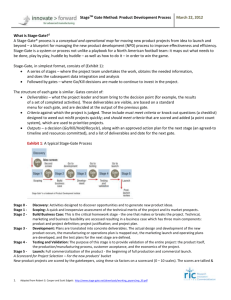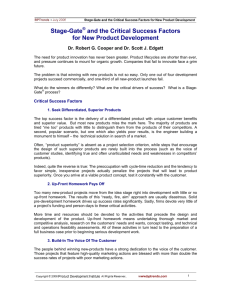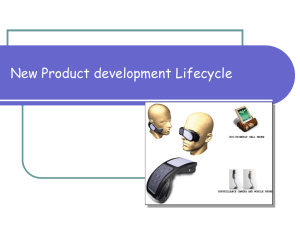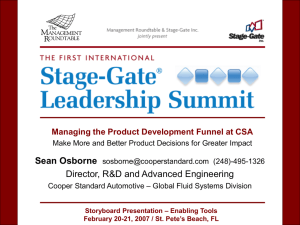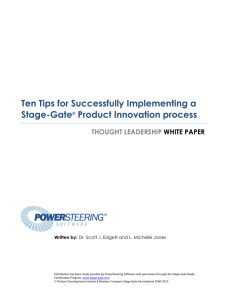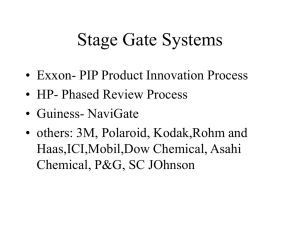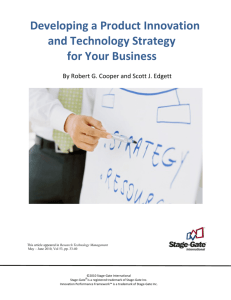Optimizing the Stage-Gate Process
advertisement
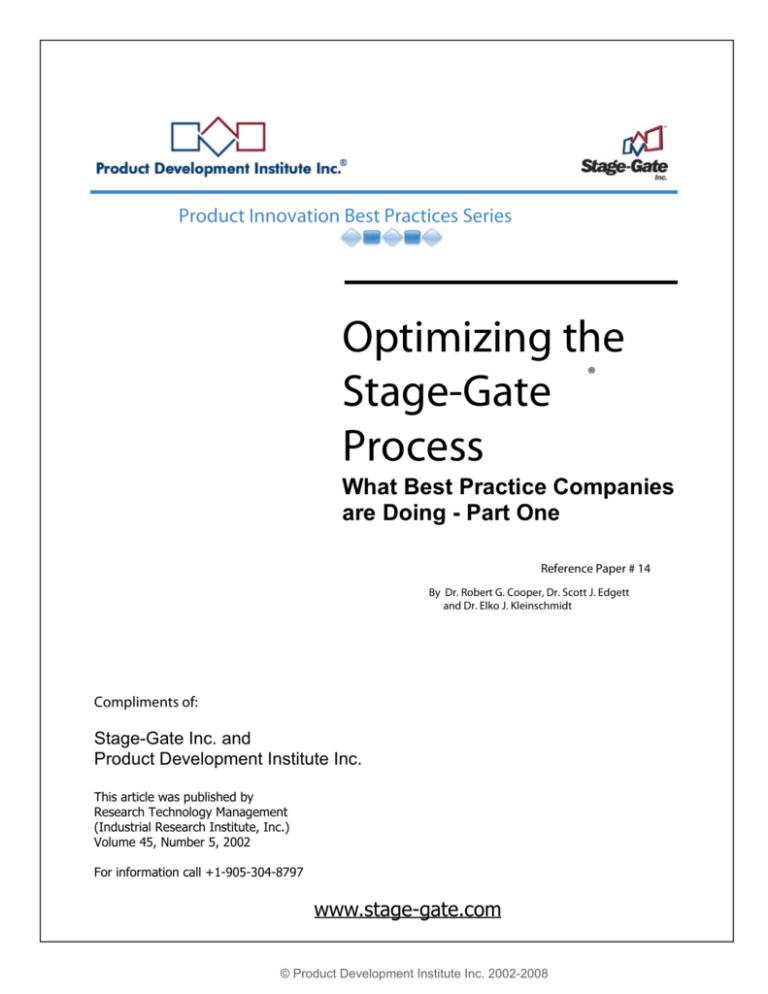
Product Innovation Best Practices Series Optimizing the ® Stage-Gate Process What Best Practice Companies are Doing - Part One Reference Paper # 14 By Dr. Robert G. Cooper, Dr. Scott J. Edgett and Dr. Elko J. Kleinschmidt Compliments of: Stage-Gate Inc. and Product Development Institute Inc. This article was published by Research Technology Management (Industrial Research Institute, Inc.) Volume 45, Number 5, 2002 For information call +1-905-304-8797 www.stage-gate.com © Product Development Institute Inc. 2002-2008 Optimizing the Stage-Gate Process ® What Best Practice Companies Are Doing - Part One By Dr. Robert G. Cooper, Dr. Scott Edgett and Dr. Elko J. Kleinschmidt Dr. Cooper, Dr. Edgett and Dr. Kleinschmidt report on their observations and experiences working with a multitude of companies, and on the practices the companies have incorporated into their product innovation processes. The following practices are explored in the paper: the addition of a discovery stage at the front end of the innovation process, harnessing fundamental research more effectively, and building in more effective go/kill decision points to move towards portfolio management. Keywords: Stage-Gate®, discovery, voice of customer research (VoC), fundamental research, and technology developments These pages contain copyright information of Product Development Institute and member company Stage-Gate Inc., including logos, tag lines, trademarks and the content of this article. Reproducing in whole or any part of this document is strictly forbidden without written permission from Product Development Inc. or Stage-Gate Inc. 2 © Product Development Institute Inc. 2002-2008 2 Optimizing the Stage-Gate Process: What Best Practice Companies Are Doing – Part One Most product developers have installed new product processes, according to a PDMA best practices study [1]. So the question is: what’s next? What are the next set of best practices to build into the way we conceive, develop and launch new products? According to the PDMA study: “nearly 60 percent of the firms surveyed ® use some form of Stage-Gate process for NPD. They are more likely to have moved from Stage-Gate processes to more simpler sophisticated facilitated or third generation processes….”.1 But other than third generation processes, which incorporate flexibility, focus, fluid stages, fuzzy gates and facilitation [2], what else are leading firms doing to enhance the effectiveness of their new product process? This two-part article reports our observations and experiences in working with a multitude of companies, and on some of the new practices they have incorporated into their new product processes. They include: 2. Harnessing fundamental research more effectively 3. Improving project selection and becoming more discriminating in the projects undertaken – this translates into building in more effective Go/Kill decision points (tough gates) and moving towards portfolio management. Topics 1 and 2 are covered in Part I of the article; topic 3 is in Part II in the next issue of RT Management. Adding a Discovery Stage to the Front End of Your New Product Process After a decade of development focused on product extensions and quick hits, the quest for the super-idea – the “home-run”, breakthrough idea or major innovation – has become a vital management issue. A good new product idea can make or break the project: ideas are the feedstock to the new product process. But don’t expect a well-oiled new product process to make up for a shortage of quality ideas: if the idea was mundane to start with, don’t count on your process turning it into a star! 1. Adding a Discovery stage to the front end of the process to generate breakthrough new product ideas ® Exhibit 1: The Most Current Stage-Gate Model with a Discovery Stage Discovery Driving NewProducts toMarket Idea Screen Gate 1 Second Screen Gate 2 Stage 1 Go To Development Stage 2 Build Business Case Scoping Gate 3 GoTo Testing Gate 4 Stage 3 Development Go toLaunch Stage 4 Gate 5 Testing& Validation Stage-Gate® is a trademark of R.G. Cooper & Associates Consultants Inc., a member company of the Product Development Institute Inc. For more information on Stage-Gate, see: www.prod-dev.com. An Idea System Capture and Handling Launch Post-Launch Review ® Stage-Gate Afive-stage, five-gate model along with Discovery andPost-LaunchReview. 1 Stage 5 What some companies are doing is replacing the traditional “light bulb” or ideation stage with a much more proactive “Discovery stage”, as in Figure 1. Here are some of the actions found in this new stage: Ideas are everywhere inside and outside of the company. The trouble is, they often lie fallow – no decisions are made on them, and no actions are taken. Leading companies, such as Guinness Breweries, establish a proactive idea capture and handling scheme, as shown in Exhibit 2. 3 © Product Development Institute Inc. 2002-2008 Here’s how it works [3]: Ideas are fed to a focal person (normally the New Product Process Manger), who then carries the ideas to Gate 1 for an initial screening. Note that there is only one on ramp to the process – all new product and product improvement ideas go via this route. The only exception is “free time” or scouting projects, where the employee uses his/her own free time to progress the idea (in such a case, install a self-managed Gate 1 – the employee does his/her own initial screen). Gate 1, the Idea Screen, consists of a small cross-functional group of mid-level managers, which meets bimonthly or monthly to review the ideas. Ideas are evaluated on a scorecard consisting of visible criteria (typically Yes/No and 0-10 scaled questions). If the idea is rejected, as most are, the idea submitter receives written feedback – how the proposed idea fared on the Gate 1 criteria, and why. Feedback is important to ensure a steady stream of ideas from wouldbe idea generators. If the Gate 1 decision is a Go, the gatekeepers nominate a small crossfunctional team – perhaps two or three people – to move the idea into the preliminary stage, Scoping. Note that the Gate 1 gatekeepers thus must have enough authority to approve these resources on the spot. Exhibit 2: Build an Idea Capture and Handling System into the Discovery Stage. Feedback to submitter Ideas Focal Person 1 Stage 1 Gate 1 Initial Screen Periodic Review & Up-Date Ideas Vault or Bank - ideas on hold - “dead” ideas Others in Company Kill or Ideas on Hold are stored in an idea vault or bank. This precludes losing good ideas whose time has not yet arrived, or which might need a little more gestation time and work. Others in the company have access to these ideas-in-the-vault via an on-line bulletinboard format. That is, employees can see the ideas, and even make suggestions for improvement. Periodically the Process Manager scans ideas in the vault. Where an idea has been augmented, s/he brings the idea once again to the Gate 1 review for a second hearing. Such a scheme has proven effective in managing the front end of the new product process. It ensures that all ideas receive a hearing; that ideas are evaluated consistently, objectively and in a timely manner; that the poor ideas are culled out fast and that the good ones receive resources and action; that idea submitters receive feedback; and that inactive ideas are not lost forever. IT support is clearly necessary not only for managing the idea vault, but also to allow electronic submission of ideas, electronic scoring of ideas at Gate 1, and electronic feedback of the decision result. Voice of Customer (VoC) Research to Uncover New Opportunities Your customer probably has your next new product idea! Building in VoC work into your new Discovery Stage helps to identify customer’s problems, unmet needs and even unarticulated needs. There is no standard methodology here, but the research usually involves working closely with the customer, listening to their problems, and understanding their business or operation and its workflow. Big ideas are solutions to solve big problems. Thus one way to begin is by focusing on your customer’s problems. As one CTO of a major U.S. corporation declared: “I employ some of the best engineers and scientists in the world … there’s hardly a technical problem we throw at them that they cannot solve. The trouble is … three-quarters of them are working on the wrong problems!”. He was referring to the tendency of technical people to jump to a © Product Development Institute Inc. 2002-2008 4 technical solution before they really understand the customer problem. When interviewing your customers, don’t merely ask them to indicate what new products or new features, functionality and performance they want – you usually get the obvious answers. Customers are invariably constrained by their inability to think beyond current experience and practice. Instead, ask: what’s bugging you? What are your problems? Most people have a long list of real and imagined gripes when it comes to almost any product or service category. One technique is reverse brainstorming, where a customer group rips apart the current solution or product, identifying all that’s wrong with it. Developing a problem inventory list, and clustering these items into major problem themes, provides the ammunition needed for beginning a creative problem solving session. Camping Out with Your Customers An anthropological style of research is used by many companies, such as HP and Fluke (instruments), to uncover unmet needs and new product opportunities. It’s called “camping out”, “fly on the wall” or “day-in-the-life-of” research (the formal term is ethno-graphic research). It involves spending time with your customers – observing them use and abuse your products, walking in their shoes, and experiencing their frustrations – in short, almost living with your customers. And this means the entire project team – engineers and scientists too – and not just the Sales and Marketing folks. The point is: if you want to study gorillas, running a few focus groups, speaking with a few salespeople, and conducting a handful of interviews probably won’t be enough. You must buy a tent and move into their site – camp out with them! Fluke Corporation of Seattle, noted for its innovative products in the field of hand-held measurement instruments, established the Phoenix team whose mandate was to deliver a superior product in a market outside of the firm’s normal scope, namely in the chemical industry. Fly on the wall research – site visits to control rooms in chemical plants by the entire team – was used to uncover the breakthrough. After some 25 site visits, the project team acquired a good understanding of the instrument engineer’s problems and needs. One problem observed was the amount of equipment engineers carried out to the plant merely to calibrate common instruments, such as pressure or temperature gauges. Every gauge and brand needed a different calibration instrument. Second, observation revealed that after the engineer had calibrated the gauge, he then took a number of readings and recorded these on a clip-board, which he later typed into his computer... a time-consuming process. And so the Phoenix team’s new product became: A universal calibration instrument – could calibrate any gauge in the plant (this was made possible via the use of software rather than hardware in the hand-hand device); and An instrument which recorded the readings in the field – the user simply keyed in readings, which went into the device’s memory; and upon returning to the control room, down-loaded these directly into his computer. The Documenting Process Calibrator product line went on to become a great success, another testimony to really understanding customer needs, and to designing a superior product in response to these needs. Working With Customers Lead or Innovative If you work with average customers, you’ll get average ideas. But, if you identify a select group of innovative or lead users, and work closely with them, then expect much more innovative new products. It’s an approach that Eric Von Hippel of MIT pioneered years ago, and has recently gained prominence at 3M as a key tool for uncovering innovative new product ideas [3]. But European firms, such as Hilti (concrete drills and fasteners), have used the approach for years. Research by Von Hippel reveals that many commercially important products are initially thought of and even prototyped by users rather than manufacturers. He also found that such products tend to be developed by “lead users” – © Product Development Institute Inc. 2002-2008 5 companies, organizations or individuals that are well ahead of market trends and even have needs that go far beyond the average user. The trick is to track down lead users, who are, by definition, rare – the right tail of the distribution curve. The lead user process has four main steps [4]: 1. Laying the foundation – identifying the target market and company goals for innovations in this market 2. Determining the trends by talking to people who have a broad view of emerging technologies and leading edge applications 3. Identifying lead users – a networking and referral process 4. Developing the breakthroughs via hosting a workshop with lead users along with key inhouse technical and marketing people. In Step 4, participants work in small groups, then as a whole, to define innovative product concepts. The Value of Scenarios One of the most significant strategic decisions in recent years was made when AT&T turned down a free offer to take control of the Internet [5]. In the late 1980s, the National Science Foundation (US government) wanted to withdraw from its role of administering the Internet, and offered AT&T a free monopoly position. But AT&T had a mental map of the future – namely a scenario or picture of the future where their centrally switched technology would remain dominant. The notion of a packetswitched technology (what Internet uses) would never work. The technical experts at AT&T concluded that the Internet was insignificant for telephony and had no commercial significance in any other context. scenario at minimum would have given decisionmakers a sense of the Internet’s potential, and may have led them to consider alternate courses of action. But developing alternate scenarios also helps decision-makers become much more sensitive to signals of change. “What has not been foreseen is unlikely to be seen in time” [6]. For example, AT&T executives, by defining the alternative scenario, might have been more alert when increasing numbers of users began to go on the web, when web-pages began to mushroom, and when PC sales to home users grew by leaps and bounds in the early 90s. Developing alternate scenarios of the future usually involves senior people taking part in extensive discussions and work sessions. Since your purpose is to arrive at new product opportunities, restrict the discussion to scenarios that are relevant to the business, and deal with the external (or extended market) environment. Questions to work on include: 1. What is the best future scenario? 2. What is the worst possible scenario? What other scenarios might occur? 3. What are some relevant dimensions that characterize these scenarios (for example, in AT&T’s case, “centralized versus decentralized switching”) Then identify the primary decisions that managers face. For example: What types of new products should you be seriously looking at? Or should you invest in a new technology or technology platform? Scenarios are utilized by imagining that one or another “future scenario” will be true, and assessing the consequences of making each decision, assuming each alternate future. Finally, markers or signals of each scenario occurring should be identified, so that managers can spot telltale signs over the next months or years as to which way the world is moving. What AT&T should have done is to develop alternate scenarios of the future. Yes, develop the scenario of the “official” or expected future … in AT&T’s case, with centrally switched architecture remaining dominant. But develop an alternate scenario too – in this case, an alternative in which new markets for Internet services and new kinds of telephony challenge the dominant AT&T architecture. Such a Harnessing the Creative Ability of Your Entire Organization – An MRG Event MRG means major revenue generator. An MRG event is an off-site company event designed to produce or scope out at least several MRGs at the end of a few days tough work. The principal is that your own people, including senior people, © Product Development Institute Inc. 2002-2008 6 often have the seeds of great new products within them. By harnessing the creative energy of the entire group, unexpected outcomes are often the result. An MRG event is a way to stimulate creativity but in a structured fashion. An annual off-site company conference of senior and middle people is the venue. The goal by then end of Day 2 or 3 is to define 2-5 major revenue generating opportunities. Participants are assigned to teams, and teams are given assignments in rounds: Round 1: Identify the major trends, shifts, changing customer needs, and potential disruptions that are taking place in your marketplace. Be sure to challenge teams to answer the key question: Do these shifts suggest any major new opportunities? After the team break-out session, teams report back. Round 2: Identify the major technology shifts in the customers’ industry that will impact the market, and might change the way you do business. Other rounds deal with similar topics, including an assessment of internal company strengths and core competencies; and shifts in the industry and value chain structure. Next, the challenge shifts from identification to opportunity mapping. That is, the teams map out some of the opportunities that their assessments have suggested – this usually means a clustering of the many new opportunity suggestions into major opportunity themes. Overnight, the event organizers work feverously to cluster and collapse these many opportunity themes into a manageable subset of major opportunities. One major bank used “concept generators” – professional artists who translated the verbiage into line-drawings, sketches, and even prototype brochures. The next morning, these major opportunities are displayed on large placards around the conference room. Now for the hard work … translating some of these major themes into actionable new product ideas. Attendees vote with their feet – they go to the cluster that they wish to work on. These self-selected “opportunity teams” are the work groups for the final session of the MRG event. Each opportunity team fleshes the opportunity out further, starts to shape the product or solution, and then maps a tentative forward plan. OMNOVA Solutions (formerly GenCorp) of Akron, stumbled across a new technology via fundamental research, which has become the platform for a number of new product projects. The new technology enables traditional polymers to have an extremely slippery surface, yet unlike other slippery materials, the resulting polymer retains its usual positive physical properties (e.g., abrasion resistance and toughness). But the technology probably would have remained buried somewhere deep within the corporation had it not been for an MRG event. In one of the breakout team rounds, a junior chemist mentioned: “What about the PolyFox research project”, reference to research being funded in the company by the Navy. The technology was surfaced, and was one of the “possibilities” identified at the event. By Day 2, a number of possible applications of this “slippery technology” were defined – ranging from graffiti-proof desk tops through to stain resistant textiles – and it was singled out as one the blockbuster opportunities emanated from the conference. A venture team was assembled right at the conference. And as this article is being written, the first products are being launched – MemeraseTM – a dry-erasable wall covering designed for meeting room walls. While an MRG event costs money and time, the rewards are worth it. The result is usually 4-5 major opportunities identified and partially defined, a core of enthused people willing to work on each, and the beginnings of an action plan. Making Fundamental Productive Research More The last decade or so has witnessed the dismantling of many corporate central research laboratories. In many businesses, fundamental research is no longer fashionable, as corporate scientists have been parceled out to the business units. The results are predicable: the research has shifted to a much shorter term © Product Development Institute Inc. 2002-2008 7 focus, and now industry leaders complain that that there is nothing great coming down the pipe. If your corporation still does fundamental research, be sure to engage this unit in the Discovery stage of your new product process. Fundamental research will often lay the seed for a great new product, product family or platform. The success rates may not be as high as for smaller, less venturesome projects undertaken within business units, but the pay-offs can be enormous. The trouble is that much fundamental research is undirected, unfocused and unproductive – which is why so many CEOs have shut it down. If fundamental research is not yielding the breakthrough projects it should, then consider introducing a little stage-gate discipline here as well. Some scientists may scream their disapproval, but remind them that this is not a university where curiosity-based research is the rule – this is a business. Other scientists will welcome the opportunity to become more engaged in value-producing research for the corporation. Here’s how to provide more direction and focus to your fundamental research lab: introduce the concept of a stage-and-gate process for science projects. For example, Exxon Chemical has modified its excellent Product Innovation Process to accommodate industrial fundamental research projects [7]. ® process for The nature of a Stage-Gate technology developments or science projects is quite different from a standard product-oriented process, with much more experimentation allowed. We call the process StageGate-TD, for technology developments: projects where the immediate deliverable is not a new product or new manufacturing process, but is new knowledge or a capability that may ultimately spawn new products or processes. The model in Figure 3 is a composite example of a technology development process for science projects (taken from a number of leading firms). Note that there are only two stages and three gates. And Gate 3 – the Application Path gate – may be combined with Gates 1, 2 or 3 in the standard new product process at the bottom of Exhibit 3 – the two processes are merged or overlapped. Exhibit 4 shows the same two-stage TD model, but with the high level stage activities listed. Exhibit 3: StageGate-TD: The Technology Development Process for Research Projects Application Path Gate Technology Developments 2 Stage 1 Gate1 Technical Assessment Stage 2 3 Detailed Investigation Project enters the NP Process at Gate 2 (sometimes Gates 1 or 3) 1 Stage 1 2 Stage 2 3 Stage 3 4 Stage 4 5 The Standard 5-Stage New Product Process The gate criteria in StageGate-TD are much less financial and more strategic in nature than for the standard new product process. For example, Toray Chemical in Japan (developers of breakthroughs such as micro-fiber and ultrasuede fabrics) uses the following rating criteria for judging their technology development projects: degree of strategic fit and strategic importance to the corporation ability to achieve strategic leverage (e.g., platform for growth; impact on multiple business units) potential for reward (value to the company, if successful) likelihood of technical feasibility likelihood of commercial success (e.g., competitive advantage; existence of inhouse competencies). If fundamental research, science projects or technology developments are undertaken in your business, try introducing a stage-and-gate process similar to that in Figure 4 in order to provide a little more direction and focus. But note that the process – its stages, gates, activities and gate criteria – will differ substantially from your new product process. Don’t try to force fit these science projects ® through your normal Stage-Gate process! © Product Development Institute Inc. 2002-2008 8 Stage 5 E xh ib it 4 : T h e F la vo r o f E a ch S ta g e in th e S ta g e G a te -T D P ro ce s s G a te 1 A p p lica tio n P a th G ate S econ d S cree n In itia l S cree n S tag e 1 T e c h n ica l A s se ss m en t S ta g e 2 D eta ile d In ve s tig atio n G a te 2 S ta g e 1 Activitie s (h ig h le ve l): 1 .U n de rta ke con ce p tua l & p repa ra tion w o rk: - te ch nica l lite ra tu re sea rch - p a ten t & IP sea rch - co m pe titive a lterna tive s a sse ssm en t - reso u rce gap s ide n tifica tion 2 .P lan & e xe cu te fea sib ility e xp e rim e n ts: - p lan fo r d efin itive exp e rim en ts - e qu ipm en t & m a te ria ls a cqu isition - e xp e rim en ta l w o rk - a na lysis & in te rp reta tio n - co m m e rcia l app lication ou tline 3 .D e ve lop A ction P lan fo r S ta ge 2 D e live ra b les : - U nde rstand ing of IP situa tion - T e ch feasibility re a sona bly d em on stra ted - D ocum en ted re su lts of e xpe rim en ts - P lan of A ction G a te 3 To NP P ro cess S ta g e 2 Activitie s (h ig h le ve l): 1 .P erfo rm te chn ica l w ork: - e xp e rim en ta l w o rk - resu lts ana lysis & repo rt prepa ra tion - e n viro nm e n tal a ssessm en t - com pe titive te chno lo gy a sse ssm e n t - te ch no lo gy p ro te ction stra te gy 2 .D e fine com m e rcia l pro du ct po ssib ilitie s: - d efin e ne w p rodu cts o r ne w p ro ce sse s 3 .U n de rta ke p relim ina ry M a rke t A sse ssm en t 4 .U n de rta ke P ro ce ss Im pa ct & Inte rest A ssessm en t 5 .U n de rta ke p relim M anufa cturing A sse ssm en t 6 .D e ve lop P re lim in a ry B u sine ss & F inan cia l A sse ssm en t 7 .D e ve lop A ction P lan (A pp lica tion s P lan ) D e live ra b les : - R esu lts of e xperim enta l w o rk (te chn ica l fe a sib ility p ro ven ) - R esu lts of com m e rcial ap plication s asse ssm en ts (pre lim ina ry o n ly) - V a lu e to the com pany d e term ined - F o rw a rd P lan s (A pp lica tio n s, IP ) Continued Next Issue The article continues with a look at more ways that leading firms are improving their Stage-Gate processes – namely, making gates more effective. 9 © Product Development Institute Inc. 2002-2008 References: 1 Griffin, A., Drivers of NPD Success: The 1997 PDMA Report. Chicago: Product Development & Management Association, 1997, p. 3. 2 Cooper, R.G., “Third-generation new product processes”, Journal of Product Innovation Management 11, 1, 1994, pp. 3-14. 3 For more information on the use of lead users in idea generation see: Von Hippel, E.A., Sonnack, M. & Churchill, J., Developing Breakthrough Products and Services: The Lead User Method. Minneapolis, MN: LUCI Press. See also: Herstatt, C. & Von Hippel, E.A., “From experience: developing new product concepts via the lead user method: a case study in a ‘low tech’ field,” Journal of Product Innovation Management 9, 1992, pp. 213-221; and: Urban, G.L. & Von Hippel, E.A., “Lead user analyses for the development of new industrial products,” Management Science, 34, 5 (May 1988), pp. 569-582. See also: Von Hippel, E.A., The Sources of Innovation. New York: Oxford University Press, 1988. 4 Adapted from: Von Hippel, E.A., Thomke, S. & Sonnack, M., “Creating breakthroughs at 3M”, Harvard Business Review, Sept.-Oct. 1999, 47-57. 5 Parts of this section on scenarios is taken from: Schwartz, P., “The official future, self delusion and value of scenarios,” Financial Times, Tuesday, May 2, 2000, Mastering Risk section, pp. 6-7. He is also author of The Art of the Long View, and former head of scenario-planning at Royal Dutch Shell. 6 See endnote 6. 7 Yapps Cohen, L., Kamienski, P.W. & Espino, R.L., “Gate system focuses industrial basic research”, ResearchTechnology Management, July-August 1998, pp. 34-37. ©Product Development Institute Inc. 2002-2008 10 World’s Top Innovation Management Scholars -Journal of Product Innovation Management, May 2007 Dr. Robert G. Cooper Dr. Robert G. Cooper is one of the most influential innovation thought leaders in the business world today. He pioneered the original research that led to many groundbreaking discoveries including the Stage-Gate® Idea-to-Launch process. Now implemented by almost 80% of North American companies, it is considered to be one of the most important discoveries in the field of innovation management. He has spent more than 30 years studying the practices and pitfalls of 3,000+ new product projects in thousands of companies and has assembled the world’s most comprehensive research on the topic. His presentations and practical consulting advice have been widely applauded by corporate and business event audiences throughout the world making him one of the most sought-after speakers. A prolific author, he has published more than 90 academic articles and seven books, including the best selling ‘Winning at New Products, 3rd Edition’. He is the recipient of numerous prestigious awards including the Crawford Fellow from the Product Development and Management Association (PDMA) and the Maurice Holland Award from the Industrial Research Institute (IRI). Dr. Cooper is a Professor of Marketing and Technology Management at the Michael G. DeGroote School of Business at McMaster University in Ontario, Canada and Distinguished Fellow at the Institute for the Study of Business Markets (ISBM) at Penn State University in Pennsylvania, USA. Dr. Scott J. Edgett Dr. Scott J. Edgett is internationally recognized as one of the world’s top experts in product innovation and is the pioneer of portfolio management for product innovation. He is a high profile speaker and sought-after consultant. Dr. Edgett has had extensive experience working with large multinational clients in a variety of industries, principally focusing on issues affecting innovation leadership and capability. He is credited with helping business executives and innovation professionals successfully implement world-class innovation processes that have generated outstanding results. His speaking engagements and consulting work have taken him around the globe to work with some of the world’s best innovators and companies among the Fortune 1000. Dr. Edgett is Chief Executive Officer and co-founder, with Dr. Robert G. Cooper, of both Product Development Institute and Stage-Gate Inc. He has spent more than 20 years researching and developing innovation best practices and working with organizations in product innovation. He is a prolific author having coauthored six books including the popular ‘Portfolio Management for New Products, 2nd Edition’ and has published more than 60 academic articles. Edgett is a former Professor of the Michael G. DeGroote School of Business, McMaster University in Ontario and former editor of the prestigious Journal of Product Innovation Management (JPIM). 11 © Product Development Institute Inc. 2000-2008 The Stage-Gate Inc. Advantage How we can help you win at product innovation Results Reach Experience Research Leadership proven track record helping companies improve their product innovation capabilities successful client engagements across numerous industries, countries and cultures breadth and depth via front line experience with 5000+ clients comprehensive, peer reviewed and longest running benchmark studies The world’s most respected experts in NPD – Dr. Robert G. Cooper and Dr. Scott J. Edgett Consistent, repeatable product innovation success is within your reach. SG Navigator™ Implementation Services The complete guide to customizing, implementing and using the authentic Stage-Gate® system. Packaged into a professional, user friendly interface accessible through your web browser, this expert guide contains a collection of the best of the best - practices, proprietary methods, criteria, templates, worksheets and deliverables. Everything you need to drive lean, rapid, and profitable product innovation in your organization. Highly focused engagements designed to accelerate the successful implementation of proven innovation practices. Based upon a collection of world class techniques and methods and delivered by highly skilled, experienced implementation specialists. Benchmarker™ Compare your organization’s innovation performance and practices against the best. This costeffective, convenient and reliable assessment isolates your strengths and weaknesses against proven performance drivers. Fact-based information to help you make critical decisions. Inspiring Speakers Invite internationally acclaimed product innovation experts, Dr. Robert G. Cooper and Dr. Scott J. Edgett, into your organization to motivate and inspire your team to embrace the proven drivers of innovation success. Seminars and In-house Training High impact, interactive and intense knowledge transfer events where our expert speakers and trainers cut through the issues and focus on best practice solutions to the most critical challenges faced by product innovators. +1-905-304-8797 Consulting Services Highly specialized engagements tailored specifically to meet your company’s unique innovation challenges and needs. Our product innovation experts draw on an impressive collection of tools, methods and expertise to help you measure, analyze, design and execute. Books and Reports Best selling books and research reports on the topics critical to product innovation success. Cooper and Edgett’s collective works are considered to have achieved the most powerful impact on performance in product innovation today. Alliance Program Connects innovators with enabling tools through a central, easy-to-access, Solutions Directory and saves time sourcing vendors to support Stage-Gate processes such as Idea Management, Idea-to-Launch and Portfolio Management. The Stage-Gate Ready Certification program validates software applications against some 200 innovation-related criteria to reduce risks and costs incurred by would-be buyers during the selection process. www.stage-gate.com 12 © Product Development Institute Inc. 2000-2008 Stage-Gate Inc. The ultimate combination of front line experience and proven, widely implemented products and services. Stage-Gate Inc. is the most widely recognized and trusted name in Product Innovation. Our clients trust and rely on our ideas, unparalleled research, worldclass solutions and outstanding service. Whatever your needs or goals contact us. We can help you win at product innovation. +1-905-304-8797 Toronto • Atlanta www.stage-gate.com 13 © Product Development Institute Inc. 2006-2008 Want to Learn More? Executive Seminars Dr. Robert G. Cooper and Dr. Scott J. Edgett invite you to attend their Innovation Best Practices Seminars Lean, Rapid and Profitable New Product Development - Improving your Productivity Developing A Product Innovation Strategy and Deciding Your New Product Portfolio Making Strategic Choices and Picking the Winners Generating Breakthrough New Product Ideas - Feeding the Innovation Funnel Winning At New Products - Achieving New Product Success with Best Practices Successfully Designing and Implementing the Stage-Gate® Process - A Best Practice Approach Portfolio Management for New Products - The Blueprint for Effective Project Selection and Prioritization Technology Developments, Platforms & Fundamental Research - Managing for Profitable Results Best Selling Books Authored by Dr. Robert G. Cooper and Dr. Scott J. Edgett these books address the complex issues surrounding product innovation. Stage-Gate Knowledge Community Receive Dr. Cooper and Dr. Edgett’s latest research, information and tips to keep you current in Product Innovation. Be the first to receive advance copies of new articles, research papers, books, seminars and more. Join www.stage-gate.com/subscribe.php +1-905-304-8797 www.stage-gate.com © Product Development Institute Inc. 2000-2008 14
